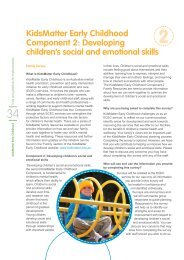Mental health risk and protective factors [436KB] PDF - KidsMatter
Mental health risk and protective factors [436KB] PDF - KidsMatter
Mental health risk and protective factors [436KB] PDF - KidsMatter
You also want an ePaper? Increase the reach of your titles
YUMPU automatically turns print PDFs into web optimized ePapers that Google loves.
3<br />
component<br />
<strong>Mental</strong> <strong>health</strong> <strong>risk</strong><br />
<strong>and</strong> <strong>protective</strong> <strong>factors</strong><br />
Children’s mental <strong>health</strong> is influenced by many <strong>factors</strong><br />
Some of the important infl uences include children’s physical, social <strong>and</strong> emotional<br />
development, family circumstances, sense of belonging to school, <strong>and</strong> access to resources<br />
<strong>and</strong> support services. The infl uences that have been found to increase the likelihood<br />
that children will experience mental <strong>health</strong> problems are known as ‘<strong>risk</strong> <strong>factors</strong>’.<br />
Other infl uences have been found to decrease the likelihood of children developing mental<br />
<strong>health</strong> diffi culties, even when <strong>risk</strong> <strong>factors</strong> are present. These are called ‘<strong>protective</strong> <strong>factors</strong>’.<br />
This overview provides information about the kinds of <strong>risk</strong> <strong>factors</strong> that can affect children’s<br />
mental <strong>health</strong>, <strong>and</strong> also about <strong>protective</strong> <strong>factors</strong> that can support children <strong>and</strong> help to<br />
reduce the <strong>risk</strong> of mental <strong>health</strong> diffi culties.
What are mental <strong>health</strong><br />
<strong>risk</strong> <strong>factors</strong>?<br />
The idea that certain <strong>risk</strong> <strong>factors</strong> make it more likely that<br />
children will experience poor mental <strong>health</strong> is based on<br />
research fi ndings that show how frequently, <strong>and</strong> under<br />
what conditions, children’s mental <strong>health</strong> diffi culties<br />
occur. Knowing what kinds of <strong>factors</strong> put children at <strong>risk</strong><br />
of mental <strong>health</strong> diffi culties helps <strong>health</strong> experts plan<br />
<strong>and</strong> develop the kinds of support <strong>and</strong> resources needed<br />
to be able to intervene early to improve children’s mental<br />
<strong>health</strong>. It also helps to guide efforts to prevent mental<br />
<strong>health</strong> problems developing.<br />
The following table shows examples of <strong>risk</strong> <strong>factors</strong><br />
(identifi ed by researchers <strong>and</strong> mental <strong>health</strong><br />
professionals) that often contribute to the development<br />
of mental <strong>health</strong> diffi culties in children. It is important to<br />
note that the presence of a <strong>risk</strong> factor does not mean<br />
that an individual child will necessarily develop a mental<br />
<strong>health</strong> diffi culty.<br />
Examples of key <strong>risk</strong> <strong>factors</strong> that influence<br />
children’s mental <strong>health</strong><br />
Child<br />
• Complications during birth <strong>and</strong><br />
early infancy<br />
• Diffi cult temperament<br />
(overly shy or aggressive)<br />
How <strong>risk</strong> <strong>factors</strong><br />
affect children<br />
While <strong>risk</strong> <strong>factors</strong> often indicate circumstances that<br />
may severely challenge children’s mental <strong>and</strong> emotional<br />
wellbeing, predicting whether or not an individual child<br />
develops a mental <strong>health</strong> diffi culty is not straightforward.<br />
For example, whether or not a child develops a mental<br />
<strong>health</strong> diffi culty after experiencing a death in the family<br />
will depend on such things as the age <strong>and</strong> emotional<br />
temperament of the child; the closeness of the<br />
relationship between the child <strong>and</strong> the person who has<br />
died; the support available through relatives, friends <strong>and</strong><br />
others; whether the death was sudden or anticipated;<br />
<strong>and</strong> the effects of any previous experiences of loss.<br />
Sometimes <strong>risk</strong> <strong>factors</strong> result from isolated events,<br />
such as a death in the family. Often, however, several<br />
<strong>risk</strong> <strong>factors</strong> are related to one another, <strong>and</strong> it is their<br />
combined effect that leads to diffi culties. For example,<br />
Denise, a sole parent, has been struggling to look after<br />
three children on her own. She has been sick <strong>and</strong> had<br />
to give up her part time job <strong>and</strong> the family has had to<br />
move. There has been disruption, economic hardship<br />
<strong>and</strong> parental illness, each of which is a <strong>risk</strong> factor for<br />
children’s mental <strong>health</strong>. When several <strong>risk</strong> <strong>factors</strong> are<br />
present there is a greater likelihood that children will<br />
experience mental <strong>health</strong> diffi culties.<br />
• Low self-esteem<br />
• Low intelligence<br />
• Poor bonding with parent/s<br />
Family<br />
• Family disharmony, instability or breakup<br />
• Harsh or inconsistent discipline style<br />
• Parent/s with mental illness or<br />
substance abuse<br />
• Siblings with a serious illness or disability<br />
School<br />
• Peer rejection <strong>and</strong>/or bullying<br />
• Academic failure<br />
• Poor attendance<br />
• Poor connection between family<br />
<strong>and</strong> school<br />
Life<br />
events<br />
• Diffi cult school transition<br />
• Death of a family member<br />
• Emotional trauma<br />
• Experience of physical or sexual abuse<br />
Society<br />
• Discrimination<br />
• Isolation<br />
• Socioeconomic disadvantage<br />
• Lack of access to support services
Protective <strong>factors</strong> for<br />
children’s mental <strong>health</strong><br />
Protective <strong>factors</strong> can help to reduce the likelihood of<br />
developing a mental <strong>health</strong> problem. The kinds of things<br />
found to be <strong>protective</strong> of children’s mental <strong>health</strong> are<br />
presented in the table to the right.<br />
Not all <strong>protective</strong> <strong>factors</strong> work in the same way. Some<br />
<strong>protective</strong> <strong>factors</strong> may help by shielding the child from<br />
experiencing a <strong>risk</strong> factor. For instance, a child who<br />
has an easy temperament (<strong>protective</strong> factor) cannot<br />
simultaneously have a diffi cult temperament (<strong>risk</strong> factor).<br />
More commonly, <strong>protective</strong> <strong>factors</strong> operate to reduce<br />
children’s exposure to <strong>risk</strong>. For example, a child with<br />
good social <strong>and</strong> emotional skills is able to make friends<br />
easily <strong>and</strong> is consequently less likely to experience<br />
social isolation (<strong>risk</strong> factor). Positive connections<br />
between family <strong>and</strong> school support children’s academic<br />
achievement <strong>and</strong> reduce the likelihood of failure.<br />
Other <strong>protective</strong> <strong>factors</strong> serve to reduce the impact of<br />
<strong>risk</strong> <strong>factors</strong>. For example, a caring relationship with a<br />
parent, carer <strong>and</strong>/or teacher provides children with a<br />
source of support to help them cope with diffi culties.<br />
Similarly, when children have a strong sense of cultural<br />
identity it can help to buffer the negative effects of<br />
discrimination <strong>and</strong> increase resilience.<br />
It is important to note that while the <strong>factors</strong> listed have<br />
been found to be associated with a reduction in the<br />
<strong>risk</strong> of mental <strong>health</strong> diffi culties, this does not mean<br />
that a particular factor or combination of <strong>factors</strong> will<br />
necessarily be <strong>protective</strong> for all children. The impacts<br />
of any of these <strong>factors</strong> may vary widely for different<br />
children <strong>and</strong> in different situations.<br />
Examples of key <strong>protective</strong> <strong>factors</strong> that<br />
influence children’s mental <strong>health</strong><br />
Child<br />
Family<br />
School<br />
Life events<br />
Society<br />
• Easy temperament<br />
• Good social <strong>and</strong> emotional skills<br />
• Positive coping style<br />
• Optimistic outlook on life<br />
• Good attachment to parents or carers<br />
• Family harmony <strong>and</strong> stability<br />
• Supportive parenting<br />
• Strong family values<br />
• Consistency (fi rm boundaries <strong>and</strong> limits)<br />
• Positive school climate<br />
• Sense of belonging <strong>and</strong> connectedness<br />
between family <strong>and</strong> school<br />
• Opportunity for participation in a range<br />
of activities<br />
• Academic achievement<br />
• Involvement with a caring adult<br />
• Support available at critical times<br />
• Participation in community networks<br />
• Access to support services<br />
• Economic security<br />
• Strong cultural identity <strong>and</strong> pride<br />
Resilience: The capacity<br />
to bounce back<br />
Though <strong>risk</strong> <strong>factors</strong> increase the likelihood of<br />
experiencing mental <strong>health</strong> diffi culties, some people<br />
who are exposed to signifi cant <strong>risk</strong> <strong>factors</strong> do not<br />
develop diffi culties. Instead they fi nd ways to overcome<br />
the particular challenge <strong>and</strong>, as a result, increase their<br />
ability to cope with diffi culties. Research into resilience<br />
has sought to identify the kinds of things that allow<br />
children (<strong>and</strong> adults) to overcome <strong>risk</strong> or adversity <strong>and</strong><br />
‘bounce back’ in this way. This has led to a range of<br />
approaches that aim to build resilience by promoting<br />
the things that strengthen children’s mental <strong>health</strong> <strong>and</strong><br />
enhance their ability to cope with diffi culties.<br />
Many approaches to resilience emphasise the<br />
development of social <strong>and</strong> emotional skills, as<br />
advocated by <strong>KidsMatter</strong> Primary. However, it is<br />
important to recognise that resilience is most<br />
effectively promoted when (in addition to learning<br />
personal social <strong>and</strong> emotional skills) children are also<br />
connected through supportive relationships with family,<br />
friends, school <strong>and</strong> community, <strong>and</strong> have access to the<br />
resources needed to help them succeed <strong>and</strong> thrive.<br />
The <strong>factors</strong> found to be <strong>protective</strong> of children’s mental<br />
<strong>health</strong> are therefore critical for helping to build resilience.
Responding to <strong>risk</strong><br />
Since children have different reactions to adversity <strong>and</strong> different ways of coping, it is important to take an individual<br />
approach when assessing whether a child is at <strong>risk</strong> of developing a mental <strong>health</strong> diffi culty. The impacts on the child of<br />
both <strong>risk</strong> <strong>and</strong> <strong>protective</strong> <strong>factors</strong>, including any culturally-specifi c <strong>factors</strong>, should be taken into account when developing<br />
strategies for building resilience.<br />
1 Reduce exposure to <strong>risk</strong><br />
Recognising the kinds of mental <strong>health</strong> <strong>risk</strong> <strong>factors</strong> children are exposed to can help to eliminate or reduce those able<br />
to be addressed. For example, by taking steps to address bullying <strong>and</strong> racism, schools can work to minimise this <strong>risk</strong> for<br />
their students.<br />
Child abuse, neglect <strong>and</strong> exposure to violence represent very serious mental <strong>health</strong> <strong>risk</strong>s for children’s development, <strong>and</strong><br />
frequently cause ongoing trauma <strong>and</strong> disadvantage that extend into adulthood. Action to stop abuse is critical to protect<br />
children’s mental <strong>and</strong> physical <strong>health</strong>. Even when the immediate trauma has stopped, the <strong>risk</strong> of mental <strong>health</strong> diffi culties<br />
remains high for children who have experienced abuse or trauma. When children have been affected by abuse or trauma,<br />
extra effort is required to assist recovery <strong>and</strong> build resilience.<br />
2 Build <strong>protective</strong> <strong>factors</strong> to reduce the effects of <strong>risk</strong><br />
In many situations, it will not be possible for parents, carers or school staff to eliminate the critical <strong>risk</strong> <strong>factors</strong> affecting<br />
children. For example, chronic illness or disability affecting parents or family members are diffi culties that place stress on<br />
children as well as families, particularly because they are chronic, dem<strong>and</strong>ing circumstances <strong>and</strong> are mostly not able to<br />
be solved. In such situations, a focus on identifying <strong>and</strong> building <strong>protective</strong> <strong>factors</strong> can help to reduce the effects of mental<br />
<strong>health</strong> <strong>risk</strong>s.<br />
Ensuring that support is available outside the immediate family (eg extended family, friends <strong>and</strong> school), <strong>and</strong> that children<br />
know how to access it, can be a particularly helpful strategy. Preventive programs designed to assist children to develop<br />
coping skills for their situations can also help to build <strong>protective</strong> <strong>factors</strong>. Examples include programs for children of parents<br />
with a mental illness, siblings of children with special needs, <strong>and</strong> children experiencing loss or family breakdown.<br />
Key points for supporting children who may be affected by<br />
mental <strong>health</strong> <strong>risk</strong> <strong>factors</strong><br />
Build caring relationships<br />
A caring relationship with at least one important adult – ideally a parent or carer – is a signifi cant <strong>protective</strong> factor<br />
that builds resilience to help children cope with diffi culties.<br />
Be aware of <strong>risk</strong>s <strong>and</strong> how your child is coping<br />
Recognising when children are exposed to mental <strong>health</strong> <strong>risk</strong> <strong>factors</strong> <strong>and</strong> observing how well they cope can help you<br />
tune into children <strong>and</strong> provide support to meet their needs.<br />
Establish a support network<br />
Children, parents, carers <strong>and</strong> families cope best when they have support. Support may be available through friends,<br />
extended family, schools, community organisations or professionals. Being able to draw on a network of support is<br />
especially necessary during challenging times.<br />
This resource is part of a range of <strong>KidsMatter</strong> Primary information sheets for families <strong>and</strong> school staff.<br />
View them all online at www.kidsmatter.edu.au<br />
Copyright: © Commonwealth of Australia 2012-13. This work is copyright. You may use this work in accordance with the terms of licence available at www.kidsmatter.edu.au


![Mental health risk and protective factors [436KB] PDF - KidsMatter](https://img.yumpu.com/38050632/1/500x640/mental-health-risk-and-protective-factors-436kb-pdf-kidsmatter.jpg)
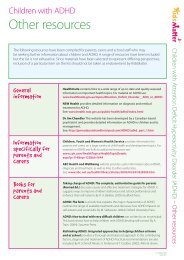
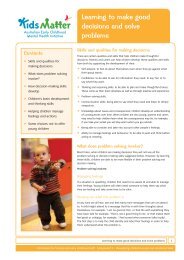
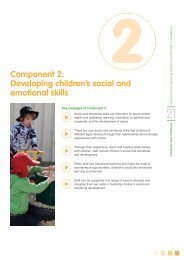
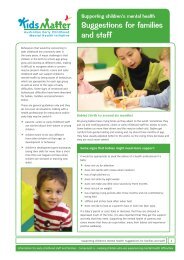


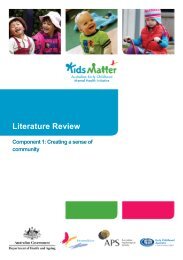

![Trinity Anglican School - Cairns story [378KB]pdf - KidsMatter](https://img.yumpu.com/41716076/1/184x260/trinity-anglican-school-cairns-story-378kbpdf-kidsmatter.jpg?quality=85)
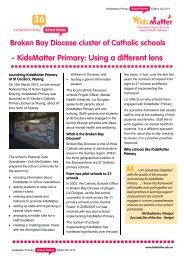
![Happy families work together [327KB] PDF - KidsMatter](https://img.yumpu.com/40767384/1/184x260/happy-families-work-together-327kb-pdf-kidsmatter.jpg?quality=85)
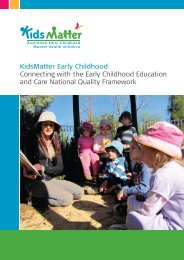
![Action Team Handbook 2012 [1.9M] [PDF] - KidsMatter](https://img.yumpu.com/38050920/1/184x260/action-team-handbook-2012-19m-pdf-kidsmatter.jpg?quality=85)
![[1008KB]pdf - KidsMatter](https://img.yumpu.com/38050895/1/184x260/1008kbpdf-kidsmatter.jpg?quality=85)
